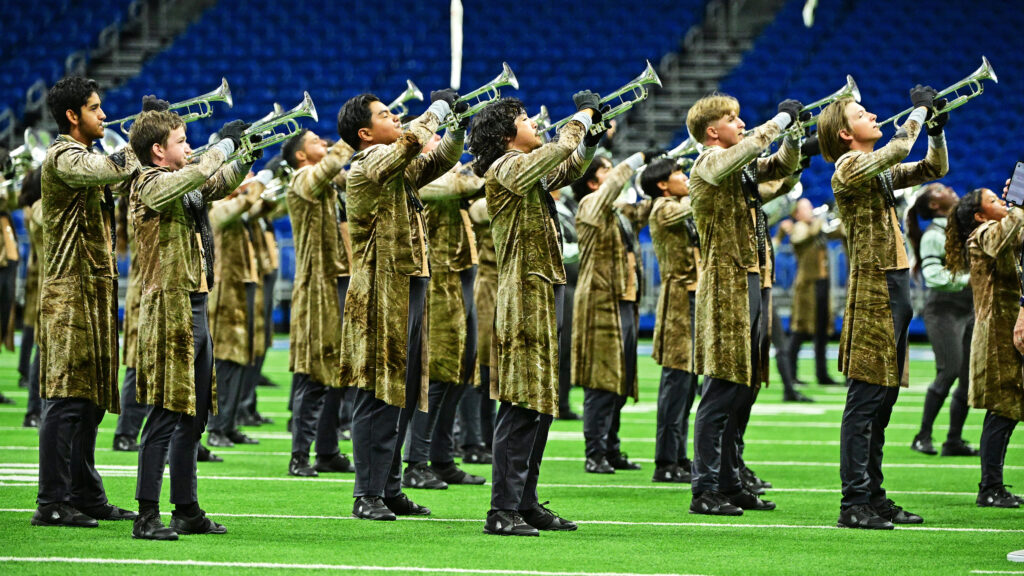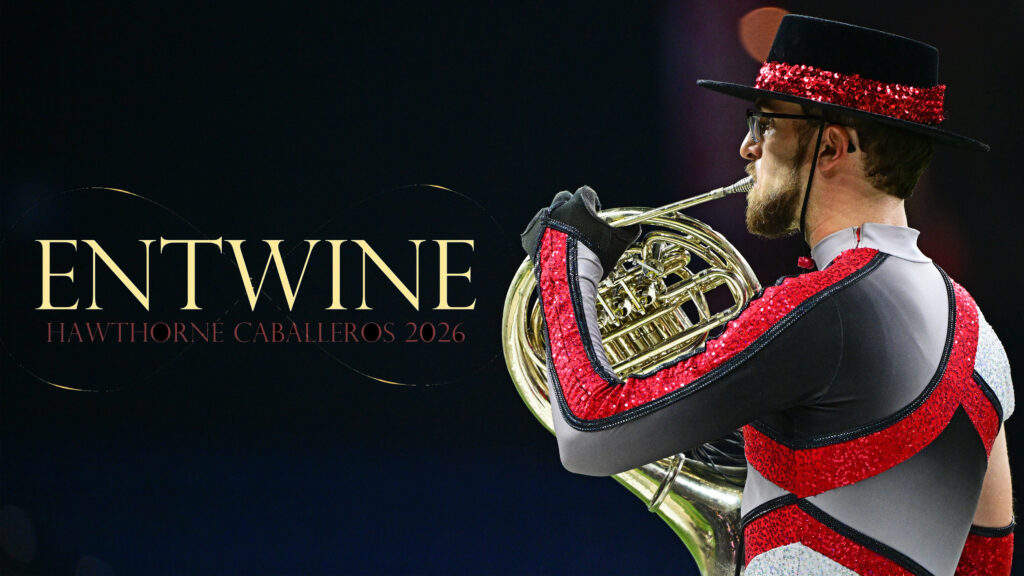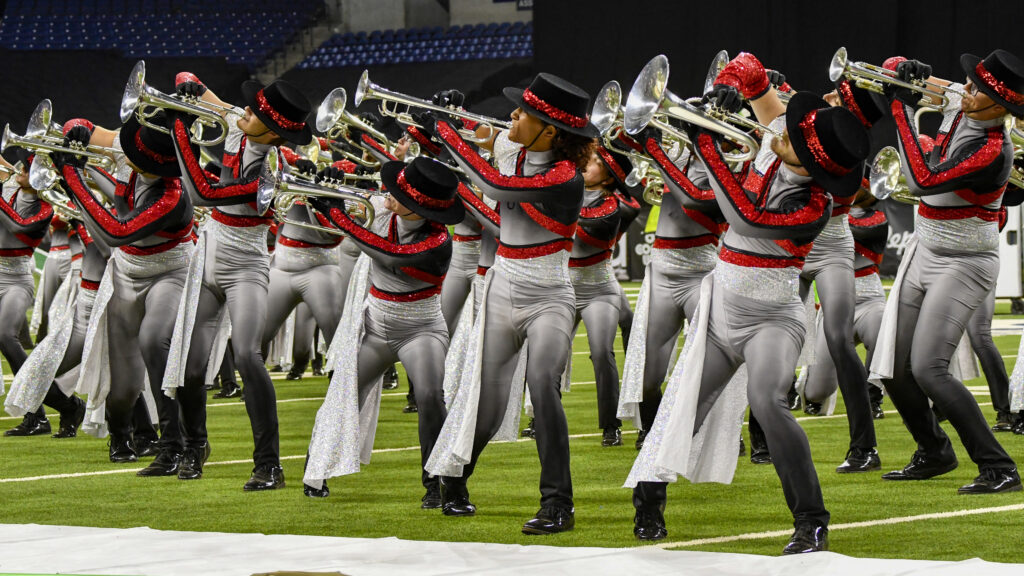Jim Mallen is a school business administrator/board secretary, and a former DCI percussion judge who lives in Wyckoff, N.J., with his wife and two sons.
He is a fan of the musical composition, “Maleguena.” Well, perhaps “fan” doesn’t quite begin to describe his passion for the work. Get ready to learn more about the piece and its place in drum corps than you perhaps ever thought was possible. In the summer of 2003, two DCI Finalist corps — Boston Crusaders and The Cadets — performed the popular marching piece entitled “Malague?±a.” Every time that they performed this piece of music, they were consistently met with unabashed joy and appreciation by the fans that witnessed their performances. Both of the arrangements and treatments were markedly different, and in many ways, each was equally successful. Let’s look first to the music itself. According to a marching music Web site corpsreps.com, it is one of the most oft-performed pieces in drum corps.
Corpsreps cites it being performed 90 times by drum corps from the year 1954 until the present. It was played 34 times by junior corps, 17 times by international corps, and 39 times by senior and alumni corps. Of the 90 times, the Hawthorne Caballeros clearly elevated it to “signature” status, having played it in 12 different years (1954, ’55, ’56, ’66, ’67, ’80, ’81, ’84, ’85, ’90, ’95, ’96)! It was played five times by the Rhode Island Matadors (1970, ’75, ’76, ’77, ’78), usually with Jim Centorino and Richie Price as their talented and wonderful soloists.
Both are Spanish-style corps, and I can only imagine how the Cabs were received when they went to Cuba and performed it there in the 1950s. In the junior corps world, the Madison Scouts hold “signature” status with seven renditions. (1963, ’65, ’78, ’80, ’81, ’88, ’96) The Hawthorne Muchachos played it four times (1969, ’73, ’74, ’77). It was played three times by Velvet Knights, Kiwanis Kavaliers, Steel City Ambassadors and Cambridge Caballeros. In the international realm, Jubal (Holland) and Yokohama Inspires (Japan) each played it twice, each during consecutive years. The number of corps that has played this tune is amazing. There is also a high incidence of corps that played it in two successive years.
The record is four years in a row by the Matadors in ’75, ’76, ’77, ’78. It is a tremendously popular and likeable piece. It apparently has staying power to the listener and is still appealing, despite repeated listenings. So who wrote this masterpiece? Do you know? I thought I did. I thought I should. But, somehow the composer’s name escaped me. His name is Ernesto Lecuona. Lecuona is known as Cuba’s greatest international composer. He was born there in 1895 and he died in 1963, and is fondly considered Cuba’s George Gershwin. He has written and published over 400 compositions.
His famous music includes some that you may know, like “Granada,” “Cordoba,” “Siboney” and “Andalucia” (a.k.a. “The Breeze and I”). Did you see Boston and Cadets perform “Malague?±a” two seasons ago? Both were awesome, yet clearly different. Jay Kennedy was the arranger for Boston’s “Malague?±a” and he said, “Boston intentionally set out to not do it in the traditional or literal way.” The “traditional” way usually meant arranging it like Bill Holman’s classic version for Stan Kenton, who has published a very successful hallmark arrangement of it.
Jay told me that Boston decided to make it more contemporary, and/or unique, by blending it with segments of “Spanish Fantasy,” written by Chick Corea. Boston’s successful programming of late has included the “blending” of familiar, likeable and memorable music. The blending of “Malague?±a” and “Spanish Fantasy” was a natural evolution of the Boston staff’s creative thinking. “Malague?±a /Spanish Fantasy” was Boston’s final production and it almost always brought the audience to its feet in response to their emotional portrayal. It began with a subdued soloist.
The pit introduced the melody while a solo female guard member portrayed a toreador. With a flower in her teeth, her sensual dance led to a brief bullfight sequence. Next, a memorable percussion feature started with a solo snare drum on one side echoed by a solo snare on the other side. Groups of two, three, then four snare drummers entered and rotated and played antiphonal percussive licks, continually rotating, moving and expanding, then suddenly smacked you in the face with 15 snare drummers playing some very tasteful stuff. Fifteen surprise snare drummers (the five toms, with great hands, rounded out the 10-person snare line) was a definite “10” moment in their show! After the 15 snares played, the brass entered with the traditional “Malague?±a” fortississimo (fff) fanfare that climaxed in four solo trumpets building a screaming chordal pyramid. Introducing the first verse of “Malague?±a,” the corps did some of it in 7/4 time to keep it interesting and different, then finished the verse with eight bars of 7/4, then in 4/4.
Then they made a seamless transition into “Spanish Fantasy.” The next percussion feature was also “Spanish Fantasy,” and then the shout section went back to “Malague?±a.” Kennedy told me that the staff designed the production to maximize entertainment, both musically and visually, which included several demanding drill moments. He said that Boston only stood still in “Malague?±a” for the opening fanfare and the ending shout chorus. Otherwise, the corps was in continual motion. Boston devotees will also appreciably note, near the finale, the almost subliminal “shots” of the “Conquest” hit, which is de rigueur for Boston arrangers (and listeners).
It isn’t the first time it appeared in Boston’s show, as there were also hints of it in their first production, too. In all, it was a fabulous finale to their show and always evoked an emotional audience response. Congratulations Boston! In 2003 you once again won our hearts, as you did in Maryland in 2000, when you also won the Disney Award. Now, the Cadets’ version of “Malague?±a” was truly something else.
They elected to take the more traditional “in-your-face” approach. But instead of using the successful — albeit predictable — arrangement for Stan Kenton, the Cadets instead used the format of the highly successful production as seen in the Broadway show “Blast!” There were 12 stunning selections in “Blast!” (starting with “Bolero”) and their show closer was “Malague?±a.” Predictably, it brought down the house every night on Broadway in 2001 and on tour. The Cadets performed three productions in 2003, if you exclude their moving warmup and surprise setup for their faux, starting-line company front to the 50-yard line.
“Malague?±a” was their second piece, preceding their closer of “Rocky Point Holiday.” I asked director George Hopkins why they picked “Malague?±a.” He said that they again wanted to give their performers a musical piece that would be a guaranteed success with the audience every night, as they did recently with “Boogie Woogie Bugle Boy” and “Moondance.” George said, “As we narrowed our possibilities, ‘Maleguena’ became a ‘can’t miss’ choice for us.” They begin with the traditional subdued intro, but soon built climactically to a knock-your-socks-off hit.
The mounted cowbells on the ten snare drums for “Malague?±a” actually took my breath away the first time I saw them, wide-eyed and open-mouthed at Giants Stadium. It was magnificent. They played an outrageous ostinato Latin cowbell lick in absolutely perfect unison, at an incredibly fast tempo, while trucking (crab walking) sideways (stage left) at approximately 30 miles per hour. Awesome. Truly a “10” moment for the Cadets. Their production was a wonderful roller coaster ride with horn solos, percussion features, and purely joyful musical moments throughout.
The ending of their “Malague?±a” production was so powerful that I watched first-time viewers go nuts, believing that this was the end and finale of the Cadets’ show. It had to be (they reasoned; erroneously, of course). How could the Cadets possibly top such a spectacular ending? The Cadets’ version had more percussion feature time than Boston’s did. It provided them opportune time to showcase that superior percussion section. In fact, “Malague?±a” was one of the key vehicles that afforded the Cadets’ percussion the exposure time it needed to be a contender for the High Percussion award. And it worked, as Cadets won the High Percussion award at the DCI Championship Finals competition.
Congratulations again to Aungst, Larrivee, all staff and players! The Cadets took some grief about their choice of music prior to the 2003 season. But by the last week in Orlando, all those complaints disappeared. I also listened to fans’ complaints about arrangers constantly changing charts and tweaking previous arrangements. They complained, “Why can’t they leave well enough alone?” They said, “When I go to hear the symphony perform classical literature, I hear what was originally written, not some arranger or conductor’s contemporary version of it.” While this statement may be sincere, it is absolutely not true. Every piece of classical literature is modified almost every time it is performed.
Each conductor puts his or her own “spin” on it. The acoustics change, the instrumentation changes, the skills of the orchestra vary, and all causes the conductor to modify the performance. In the 1990s, I spent nine years as principal percussionist with a community group, the Ridgewood Symphony Orchestra. In my experiences there, every conductor altered what was originally composed. In the 02.15.2004 New York Times, Leonard Slatkin, music director of the National Symphony Orchestra in Washington, D.C., said, “Throughout music history, from the time standard repertory developed, performers have, under the heading ‘interpretation,” added their own touches to past masterpieces.” Composer Gustav Mahler was also a highly respected conductor, and he is also famous for his published “retouchings” of Beethoven, Schubert and Schumann symphonies.
Mahler noted that Beethoven had an ear problem that ultimately left him deaf, and he lost touch with the world of physical sound. Also, Slatkin quotes Mahler citing changes in instruments and orchestra size as reasons for modifying the scores. In Beethoven’s time, the string section might have six or eight violins and one double bass. Mahler’s versions would have 20 or more 1st violins and 10 to 12 double basses (like Strauss). Such an enlarged body of strings would drown out certain original woodwind passages; so Mahler would double (and triple) a flute part, and maybe add an E-flat clarinet.
Instruments also changed and improved. “French horns in Beethoven’s time were ‘natural’ instruments,” said Slatkin. Lacking valves, they couldn’t play chromatic passages. Mahler simply filled in the spaces where notes were missing. Also, the range of most woodwind instruments increased, so Mahler used the added notes to keep the flutes from having to drop an octave for a note or two. Beethoven used blocks of dynamic levels in his writing. If he marked a passage fortissimo, then the whole orchestra had fortissimo. Conductors now commonly adjust these levels. So, why do I digress into Mahler’s rewriting of Beethoven? My point here is that, in drum corps, we too have had radical changes in size, acoustics, ability, and of course, instrumentation. So we should understand and accept (and applaud) current versions of drum corps literature that have been modified to adapt to our new criteria. Slatkin concluded his article by saying, “Great art flourishes precisely because it can be construed in different ways by succeeding generations.” I agree completely.
And we can only hope that our drum corps activity also continues to flourish as it is construed differently by succeeding generations. And what is my point of comparing the two “Malague?±as?” I do so to support my contention that our standard drum corps literature and repertory can be wonderful, most effective, and gratifying, even at the highest levels of DCI. I do not believe that a corps needs to play obscure, unknown (or invented) music in order to be considered to be “breaking new ground.” I also believe that Boston and Cadets proved this point emphatically in 2003 by their successful performances of a true drum corps “standard” — “Malague?±a!”
Michael Boo has been involved with drum and bugle corps since 1975, when he marched his first of three seasons with the Cavaliers.
He has a bachelor’s degree in music education and a master’s degree in music theory and composition.
He has written about the drum corps activity for over a quarter century for publications such as Drum Corps World, and presently is involved in a variety of projects for Drum Corps International, including souvenir program books, CD liner notes, DCI Update and Web articles, and other endeavors. Michael currently writes music for a variety of idioms, is a church handbell and vocal choir director, an assistant director of a community band, and a licensed Realtor in the state of Indiana.
His other writing projects are for numerous publications, and he has published an honors-winning book on the history of figure skating. His hobbies include TaeKwonDo and hiking the Indiana Dunes. But more than anything, Michael is proud to love drum corps and to be a part of the activity in some small way, chronicling various facets of each season for the enjoyment of others.





